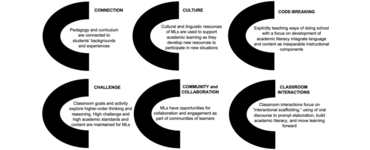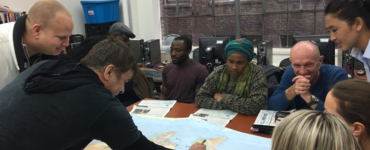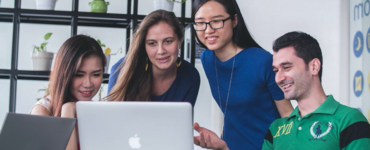Based on field research and observations, this work challenges existing assumptions about using technology to support learner engagement and recommends tech-rich instructional strategies made possible when teachers engage critical consciousness and reflection to create equitable learning spaces.
Key words: equity, culturally and linguistically diverse families, teaching, technology
Introduction
Learner access to technologies and the instruction delivered through them does not equate to inclusion unless paired with a focus on opportunity and justice. Educators and political leaders are attempting to redefine teaching and learning expectations to create equitable educational contexts in a time of crisis. Despite this effort, we argue that schools have contributed to the moment in which we are living—where access to technology supported learning is not equitable (Vakil, 2018). Furthermore, we argue that with the onset of COVID-19, instructional actions surrounding the equitable use of technology and antiracist pedagogies1 are central to the provision of inclusive learning opportunities. Thus, subsequent conversations have begun to explore the gaps that have widened-under the radar.
What has been missing in the rush to move teaching and learning online is building relations of trust with the family and enhancing teaching capacities for accommodation readiness (Herrera & Murry, 2016), which leads to authentic cariño (Bartolomé, 2008; Herrera et al., 2020; Valenzuela, 1999). This Spanish term shared especially among Latinx caregivers/families is a linguistic variant of the Spanish word corazón, or heart. In education, children from various cultures share some notion of heart as a metaphor for empathy, caring, and giving. Just as the heart supplies the lifeblood to the human body, authentic cariño embodies genuine understanding, compassion, and unequivocal responsiveness as well as action to promote learning spaces wherein Emergent Bilinguals and their families are able to see their academic, sociocultural, cognitive, and linguistic assets as key parts of the curriculum (Herrera, 2016). The authors recognize that many teachers are already balancing the notion of authentic cariño to care for their students and their families; however, external forces sanctioned by monolingual/standardized orientations make this work both challenging and stressful.
Identifying the issues
As a result of COVID-19 and Black Lives Matter (BLM), educators are tasked with being cognizant of the intersectionality of race, social justice, and equity. While BLM is a movement that has highlighted the copious inequities Black communities have always faced, it has a ripple effect on long-standing systemic inequities in the classroom. Noting the diversity found within our culturally and linguistically diverse (CLD) families and students, it is crucial to be aware of the socio-political complexities, and how they impact teaching and learning, yet this is not happening uniformly.
Addressing what comes first: Is technology the great equalizer?
School districts are racing to purchase additional technological devices for students as the nation’s K-12 schools deepen reliance on e-learning. While well-intended, and an important first step, these initiatives are reactionary and may reinforce socioeconomic and racial divisions, particularly for Emergent Bilinguals. Educational systems are still trapped in the dichotomous rhetoric of the “digital divide” that equates equity with access. Research has challenged the limitations of this concept and what digital equity truly means (DiMaggio & Hargittai, 2001; Talaee & Noroozi, 2019; Warschauer, 2004). The issue with technology is not so much about being connected, rather it is about the inequities that exist for connected users. One approach schools have taken in the name of “bridging the digital divide” has been to purchase and provide devices (e.g., typically a tablet, Chromebook, or laptop) for each child. Purchasing a computer/tablet for each child is not going to rid the systematic institutionalized lack of preparedness for transforming schools to embrace equity as they create pathways for academic success for Emergent Bilinguals and their families. Successful moves toward equity must move beyond provision of devices and begin to recognize the hegemonic influences of white middle-class culture in the curriculum, school culture, and school system’s relationship with families and communities (see Bonilla-Silva, 2006; Burke, 2012).
Defining cultural capital: An asset-based perspective
As a system, we have traditionally relied upon structures to provide equity, failing to dig deeper into the cultural and linguistic assets, or cultural capital, of CLD families and Emergent Bilinguals. Bourdieu’s (1984) cultural capital is defined as the collective of socially mediated skills, norms, and behaviors that enhances social mobility and creates academic, economic, and social opportunities. All families possess cultural capital; yet, not always does it encompass technological capital traditionally defined by school systems (Selwyn, 2003). Families often use familiar technologies to stay connected and find resources to support their children’s learning experience. For example, WhatsApp is a very common technology used around the world. A mother taking a picture of homework and sending it to a bilingual tutor using WhatsApp for support is an example of cultural capital that bridges into technological capital. In this example, critical consciousness challenges the assumption held within educational spaces about what type of technology counts, and how CLD families often use it to support their children. This is where the link is lost between the cultural, linguistic, and technological capital.
Acts of courage: Transforming learning spaces
Given this moment of transformation and resistance, educators must embrace acts of courage in which they find themselves in dissonance with the fossilized practices embedded in the educational system. As educators try to navigate an educational environment in-flux, agency, reflection, and action become non-negotiable. Hence, pedagogical decisions should be guided by the following premises:
- Technology is currently enacted using a monocultural/monolingual lens.
- The connection is absent between cultural, linguistic, and technological capital.
- Antiracist pedagogies require critical reflection, agency, and transformation.
Instruction resting on these premises opens the door to antiracist pedagogies (see Dei, 1996; Kendi, 2019) that make visible students who are already marginalized by the system and shifts the focus of technology-enhanced efforts to the authenticity of learner assets, identified needs, and culture-bound funds of knowledge. If we are to adopt antiracist pedagogies in the midst of a pandemic, we must rethink curriculum and technology purposes, deployment, and maximization.
When teaching is enacted to liberate (Freire, 1968), the goal for educators should be to shift the learning paradigm (Barr & Tagg, 1995) so knowledge can be generated at home using multiple entry points. Rather than continuing to rely upon school-centric “push-out” initiatives, educators need to re-envision how to harvest or “pull-in” the biography of the families utilizing whatever technology is available at home (Barko-Alva, Porter, & Herrera, 2020). Table 1 offers examples of instruction that can capitalize on the potential of technology to enable a more inclusive, just, and asset-driven perspective. These examples are derived from the collective works of the authors as researchers and practitioners.
| Table 1 Cultural Capital: Family skills-based approach | ||
| Subject Area | Technology Use | Product |
| Language Arts | Use your phone to record or take pictures of your community and provide a quick description on how COVID19 has impacted the people who live around you. | In response to the pictures you have taken: Interview family members about their experiences during the pandemic. Write a summary (using all your languages) and share with your teacher or a family member. |
| Ask a family member to write the steps to a favorite family recipe, create a video or home-made eBook,and use the phone to share the recipes with others. | Homemade video/eBook of family recipe to distribute. | |
| Utilizing the technology available, computer, tablet, iPad, or phone, and have the student prepare a service announcement based on a reading. Upload and share to the social media of your choice (i.e., Facebook, WhatsApp, Twitter, Text-messaging). | A persuasive, informative, or entertaining video. | |
| Science | Using WhatsApp, create a way to monitor and document the weather throughout the week. | A week’s worth of weather monitoring and documentation to share daily with your WhatsApp network (or other social media platforms). |
| Think about a science experiment you would like to conduct that documents what has happened with the environment since the beginning of the pandemic. Pose a question and document your findings. | Share what you learn over social media or share it with a caregiver/family member. | |
| Math | Create a word problem using materials you have at home. Record yourself reading the problem (i.e., with a smartphone, iPad, or tablet). | Send problems and challenge your techamigos technology friends) to find the answer. |
| Think about what your family members do at home or work that require them to use math. Ask them to take a picture of themselves at their job. Interview them and ask what type of math they use every day. Create a short infomercial sharing their math story and highlighting their profession/trade. | Send your infomercial out to the world via your caregiver/parent’s favorite social media outlet (i.e., WhatsApp, Instagram, TikTok) | |
| Social Studies | Find and listen to different podcasts/news stories that highlight how two different countries are addressing the challenges brought by COVID-19. Use any language to gather information. | Create a pictograph or collage of possible solutions
Compare and contrast both approaches. Based on the evidence, which country would you support? This could be done in English or home language. Using your phone, send a survey to find out which country’s initiatives they would support. |
| Specials | Celebrate the arts and get moving! | Create a video teaching someone a new skill in art, dance, or music. Bonus points if it is connected to your culture. |
Authentic cariño as action
Without examining our practices, advocating for antiracist pedagogies as well as utilizing technology and its potential to create equitable learning spaces in the classroom, we fall short of providing inclusive instruction. Students and families’ biographies best inform educators in their efforts to demonstrate authentic cariño in teaching and learning (Herrera et al., 2020). Models advocating meaningful change must be situated to the current and future context of teaching and learning, which has always needed to embrace the fight against racism and discrimination. The use of technology and anti-racist pedagogies can be stabilizers during this pandemic and sociopolitical revolution to embrace families’ cultural capital. If schools are driven by prescriptive programming, they remain disconnected from creating meaningful and innovating technological spaces that foster and promote authentic connections with Emergent Bilinguals and their families. Authentic cariño creates possibilities for transforming how technology is used in the classroom to build upon CLD families’ cultural capital while revolutionizing teaching and learning into actions that embrace equity, social justice, and inclusion.
Notes
- Antiracist pedagogies refer to instructional practices that actively dismantle the predominant white narrative found in US schools, while promoting equity and justice in the curriculum and elevating the voices that have been silenced throughout history (see Dei, 1996; Kendi, 2019).
References
Barko-Alva, K., Porter, L., & Herrera, S.G. (2020). Technology as technocracy: Pre-service teachers’ conscientious use of technology for authentic family engagement. In R. E. Ferdig, E. Baumgartner, R. Hartshorne, R. Kaplan-Rakowski, C. Mouza (Eds.), Teaching, technology, and teacher education during the COVID-19 pandemic: Stories from the field (pp. 765-768). Association for the Advancement of Computing in Education (AACE).
Barr, R., & Tagg, J. (1995). From teaching to learning: A new paradigm for undergraduate education. Change, 27(6), 12-16. https://doi.org/10.1080/00091383.1995.10544672
Bartolomé, L. (2008). Authentic cariño and respect in minority education: The political and ideological dimensions of love. The International Journal of Critical Pedagogy, 1(1), 1-16.
Bonilla-Silva, E. (2006). Racism without racists: Color-Blind racism and the persistence of racial inequality in the United States (2nd ed). Rowman and Littlefield
Bourdieu, P. (1984). Distinction. Harvard University Press.
Burke, M. (2012). Discursive fault lines: Reproducing white habitus in a racially diverse community. Critical Sociology, 38(5), 645-668. https://doi.org/10.1177/0896920511411207
Dei, G. J. (1996). Critical perspectives in antiracism: An introduction. Canadian Review of Sociology/Revue Canadienne de Sociologie, 33(3), 247-267. https://doi.org/10.1111/j.1755-618X.1996.tb02452.x
DiMaggio, P., & Hargittai, E. (2001). From the ‘digital divide’ to ‘digital inequality’: Studying internet use as penetration increases. Working Papers 47. Princeton University, Woodrow Wilson School of Public and International Affairs, Center for Arts and Cultural Policy Studies. Retrievable from https://ideas.repec.org/p/pri/cpanda/workpap15.html.html
Freire, P. (1968). Pedagogy of the oppressed. Seabury Press.
Herrera, S. G. (2016). Biography-driven culturally responsive teaching. Teachers College Press.
Herrera, S. G., & Murry, K. M. (2016). Mastering ESL/EFL methods: Differentiated instruction for culturally and linguistically diverse (CLD) students (3rd ed). Pearson.
Herrera, S. G., Porter, L., & Barko-Alva, K. (2020). Equity in school-parent partnerships: Cultivating community and family trust in culturally and linguistically diverse classrooms. Teachers College Press.
Kendi, I. X. (2019). How to be an antiracist. Random House.
Selwyn, N. (2002). Defining the ‘digital divide’: Defining a theoretical understanding of inequalities in the information age. Cardiff University.
Talaee, E., & Noroozi, O. (2019). Reconceptualization of “digital divide” among primary children in an era of saturated access to technology. International Electronic Journal of Elementary Education, 12(1), 27-35. https://doi.org/10.26822/iejee.2019155334
Valenzuela, A. (1999). Subtractive schooling: U. S.-Mexican youth and the politics of caring. State University of New York Press.
Vakil, S. (2018). Ethics, identity, and political vision: Toward a justice-centered approach to equity in computer science education. Harvard Educational Review, 88(1), 26–52. https://doi.org/10.17763/1943-5045-88.1.26
Warschauer, M. (2004). Technology and social inclusion: Rethinking the digital divide. MIT press.











